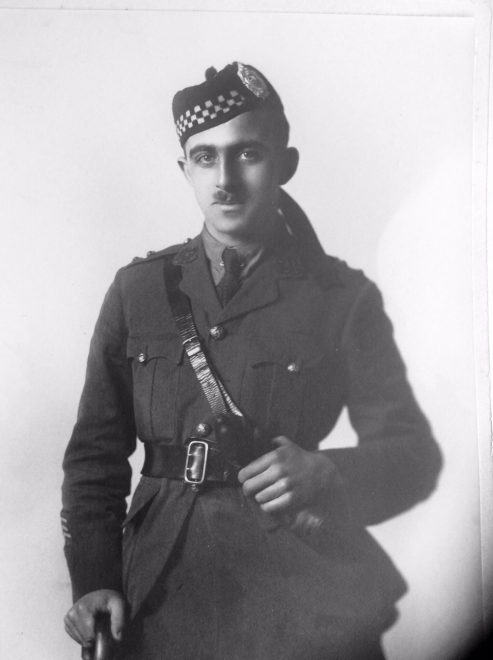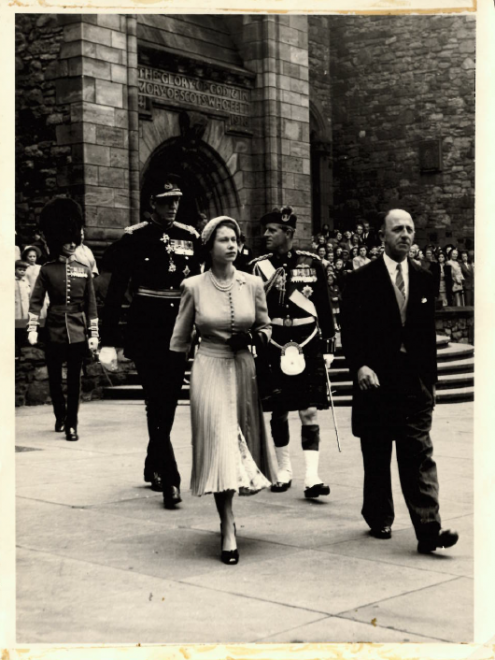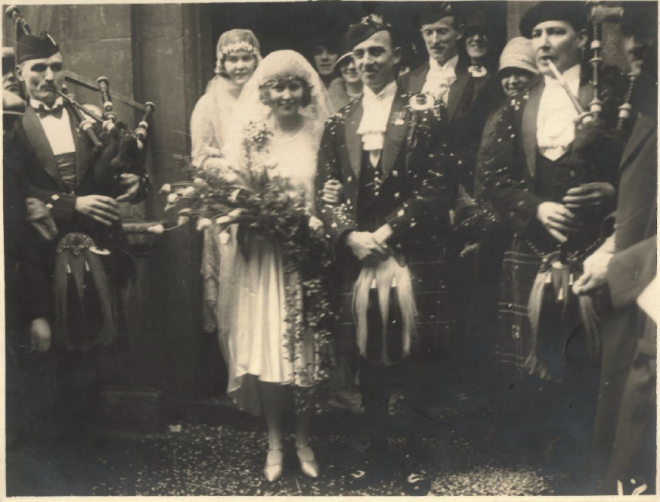David Lowe Macintyre VC CB (1895-1967)
“The Second World War might easily have seen the end of one example of First World War commemoration in the Scottish military tradition.
The Scottish Naval and Military Museum at Edinburgh Castle closed in 1939, and its collection was put into safe storage for the duration of hostilities. With administrative arrangements uncertain, and with antique military tradition somewhat out of fashion, the museum continued to languish at the war’s end and its future existence was far from assured. That it eventually re-opened was largely thanks to one man’s belief in its importance.
David Lowe Macintyre VC CB was a senior civil servant, Under-Secretary to the Ministry of Works, the government department that took on the running of the museum at his behest. Macintyre was also a living embodiment of the Scottish military tradition, a Gaelic speaking highland officer who volunteered for the Army in 1915 and was awarded a Victoria Cross for gallantry while serving on the Western Front in August 1918. This hero of an earlier war saw to it that the connections to Scotland’s military past, exemplified by the museum’s collection, would remain open for Scots and visitors to Scotland to appreciate.”
– The Thin Red Line: War Empire and Visions of Scotland by Stuart Allan and Allan Carswell, published by National Museums Scotland

Studies interrupted
Our grandfather, David Lowe Macintyre, was born on 18 June 1895 at the Free Church Manse in Portnahaven, Islay, Argyll, the second of seven sons. Growing up a Gaelic speaker, David initially attended the village school at Portnahaven before attending George Watson’s Boys College in Edinburgh from 1908. In 1914, he entered the University of Edinburgh as a Student of Arts, where he joined the Officer Training Corps (OTC). However, after two years as a university student, his studies were interrupted.
The First World War begins
David was gazetted to 13 (Reserve) Battalion, Argyll and Sutherland Highlanders and then attached to 1/6th Battalion, Highland Light Infantry (City of Glasgow). He arrived in Egypt in March 1916 and was involved in the Battle of Romani a few months later. This was followed by the Second Battle of Gaza in April 1917, although the British forces were unable to break down the defences and the attack broke down. Subsequently, David was appointed Temporary Lieutenant and then Temporary Captain.
Under General Allenby, the British Forces attacked the Turkish positions at Gaza on 1 November 1917, beginning the third and final Battle of Gaza. After weeks of fighting with heavy losses on both sides, Jerusalem was surrounded and the Turks gave up without a single shot being fired into the city.
The Victoria Cross
In April 1918, David was posted to France as Acting Captain. He was then appointed Adjutant of 6th Battalion, Highland Light Infantry.
David was in action near Henin Fontaine, France on 24 August when he was constantly in evidence in the firing line, inspiring confidence amongst all ranks by his coolness under the heaviest fire. He was again in action at Croiselles, France on 27 August when in command of the firing line during an attack. When barbed wire was encountered, he personally reconnoitred it before leading his men forward. On one occasion he organised his men to cut gaps in extra strong entanglements under heavy machine-gun fire.
When the line was held up at the Humber Redoubt, he rallied a small party, which included Serjeant James Smith and Macintyre’s Batman, Private Andrew Taylor, and pushed forward through heavy fire in search of an enemy machine-gun detachment. He came upon them in a pill-box and killed three and captured an officer, ten other ranks and five machine guns. His party raided three pill-boxes and disposed of the occupants, thus allowing his comrades to capture the redoubt. After his battalion was ordered to take up a defensive position, and after he had been relieved of command of the firing line, he reconnoitred the right flank, which was exposed. An enemy machine gun opened up on him, so he charged it single-handed and put the enemy to flight and brought in the gun. He then continued to show splendid spirit while supervising consolidation and for his gallantry, he was awarded the Victoria Cross.
He was decorated with the Victoria Cross by HM King George V in the ballroom at Buckingham Palace on 13 December 1918. Following the First World War, on 11 November 1920, a memorial to the Unknown Warrior was consecrated in Westminster Abbey. A Guard of Honour at the ceremony was formed by some 90 then current holders of the Victoria Cross, including David Lowe Macintyre.
A race against time
After recovering from the wounds he suffered in action and being discharged on 14 January 1919, David made arrangements to sit the Civil Service Entrance Examinations. Having returned to Edinburgh University that year, David, with two Islay students (both named McIver) and a McAlpine, decided to go to London for the Civil Service Examinations. There was a railway strike in October 1919 – so some things don’t change in 100 years – and this looked like dashing their hopes, but they hired a taxi on Princes Street. It took two days, and they had to feed the driver, but it did not cost much more than the railway. The taxi then broke down 30 miles from London but they found a bus, to arrive breathless just in time for the examination. The four Macs got appointments out of hundreds of candidates … whether on their initiative, or academic knowledge, they were left to wonder.
Therefore, in 1920, David entered the Civil Service. In 1936 he became Principal of the Office of Works in Scotland and, at his retiral in 1959, he was Under Secretary Ministry of Works (Scotland). He was appointed a Companion of the Civil Division of the Order of the Bath (CB) in the New Year’s Honour List on 1 January 1949.
Opening the Museum
The National War Museum was founded at Edinburgh Castle in 1930 as the Scottish United Services Museum to tell the story of Scotland’s Armed Forces. However, it closed following the outbreak of the Second World War in 1939.
As Head of the Department, David was responsible for many tasks including maintenance of Government buildings, Ancient Monuments (such as Edinburgh Castle) and Royal Parks and Gardens. Three years after the war ended, the Museum was transferred to the Ministry of Works. Under David’s watch, the buildings were thoroughly reconditioned and redecorated by the Ministry and a separate admission charge was abolished. On 14 April 1949, David presented the key to the Governor of the Castle in Command who then formerly opened the Museum.
One other interesting duty which he had to perform from time to time was escorting dignitaries when they visited Edinburgh Castle and other similar buildings.

The next chapter
On 20 February 1929, David married Elspeth Moir Forsyth. They had two children, Alasdair and Jean, and in due course, five grandchildren and six great-grandchildren.

Although David relinquished his commission on 1 September 1921, he served in No.4 Relief Battery Home Guard in Hyde Park, London in the rank of Captain during the Second World War.
David died on 31 July 1967 at the Civil Service Nursing Home, Edinburgh. A Service of Remembrance was held at Corstorphine Parish Church, conducted by The Very Reverend Dr. Charles L. Warr, K.C.V.O., D.L., D.D., L.L.D., Minister of St Giles, who was assisted by the Reverend James Currie, a close relative and Minister of the Church of Scotland in Pollock. He was cremated at Warriston Crematorium, Edinburgh and his ashes were scattered in the Garden of Remembrance.
Into the collections
After his death in 1967, his medals were held by his widow, Elspeth. It was her express wish that the medals should be donated to the Museum at Edinburgh Castle, given David’s role in the reopening.
Following her death in 1996, David and Elspeth’s daughter and son, and their respective families, decided that her wish should be carried out and on 23 November 1998 at a luncheon in the Officer’s Mess at Edinburgh Castle, the Medals were officially handed over by six family members. In addition, David’s Smith & Wesson .455 revolver was presented to the Argyll and Sutherland Highlanders and it is on display at the Regimental Museum at Stirling Castle.

In August 2018, exactly 100 years on from the events for which Lieutenant David Lowe Macintyre was awarded the Victoria Cross, a commemorative plinth was unveiled in his place of birth, Portnahaven, Islay. The ceremony was attended by members of his close family, including his daughter Jean, grandchildren, and great grandchildren, as well as also representatives from his two Army regiments, his school in Edinburgh, local representatives of Argyll and Bute council and the Scottish Parliament together with Portnahaven residents.
Researched by the late Alasdair Macintyre (son) and written by Caroline Macintyre and Gillian Gallacher (granddaughters)
